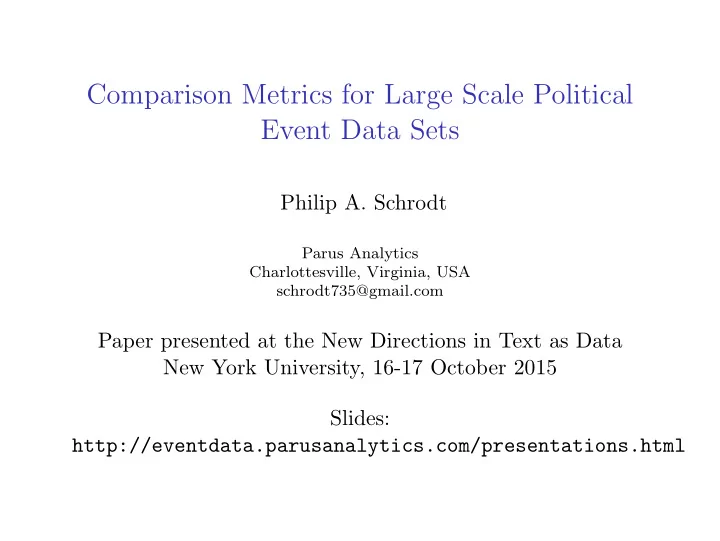

Comparison Metrics for Large Scale Political Event Data Sets Philip A. Schrodt Parus Analytics Charlottesville, Virginia, USA schrodt735@gmail.com Paper presented at the New Directions in Text as Data New York University, 16-17 October 2015 Slides: http://eventdata.parusanalytics.com/presentations.html
Outline ◮ Why multiple sources are not necessarily a good thing ◮ A comparison metric for event data sets ◮ Example 1: BBC single-source data set vs ICEWS multi-source ◮ Example 2: shallow (TABARI)vs full (PETRARCH) parsing for the KEDS Levant data ◮ Example 3: Generate data using simple pattern matching and “bag of words” methods ◮ Next steps
Humans use multiple sources to create narratives ◮ Redundant information is automatically discarded ◮ Sources are assessed for reliability and validity ◮ Obscure sources can be used to “connect the dots” ◮ Episodic processing in humans provides a pleasant dopamine hit when you put together a “median narrative”: this is why people read novels and watch movies.
Machines latch on to anything that looks like an event
This must be filtered
Implications of one-a-day filtering ◮ Expected number of correct codes from a single incident increases exponentially but is asymptotic to 1 ◮ Expected number of incorrect codings increases linearly and is bounded only by the number of distinct codes Tension in two approaches to using machines [Isaacson] ◮ “Artificial intelligence” [Turing, McCarthy]: figure out how to get machines to think like humans ◮ “Computers are tools” [Hopper, Jobs]: Design systems to optimally complement human capabilities
Weighted correlation between two data sets A − 1 A n i,j � � wtcorr = N r i,j (1) i =1 j = i where ◮ A = number of actors; ◮ n i,j = number of events involving dyad i,j ◮ N = total number of events in the two data sets which involve the undirected dyads in A x A ◮ r i,j = correlation on various measures: counts and Goldstein-Reising scores
BBC vs. ICEWS: Correlations over time: total counts and Goldstein-Reising totals
Correlations over time: pentacode counts
Dyads with highest correlations
Dyads with lowest correlations
TABARI vs PETRARCH
TABARI vs PETRARCH: High frequency dyads generally have higher correlations
TABARI vs PETRARCH: Palestine is an outlier
Experimenting with minimal “bag of words” approaches ◮ PETRARCH AFP and Reuters Levant data is the reference set ◮ Actors and agents: simply look for the patterns found in generic dictionaries ◮ Events: use support vector machines on lede-sentence texts to classify these into pentacodes ◮ Experiment 1: train on 400 cases, test on remainder ◮ Experiment 2: train on first half of cases, test on remainder
Pattern-based recognition of actors and agents
SVM event classification: 400 training cases for each category
SVM event classification: 50% training cases for AFP
SVM event classification: 50% training cases for Reuters
OEDA NSF RIDIR Project ◮ Sustained support for the Phoenix real-time data ◮ Long time-frame data sets based on Lexis-Nexis ◮ Open-access gold standard cases ◮ Coding systems in Spanish and Arabic, possibly extended to French and Chinese ◮ Further improvements in automated geolocation ◮ Automated dictionary development tools ◮ Extend CAMEO and standardize sub-state actor codes: canonical CAMEO is too complicated, but ICEWS substate actors are too simple ◮ Develop event-specific coding modules, starting with protests
Thank you Email: schrodt735@gmail.com Slides: http://eventdata.parusanalytics.com/presentations.html Data: http://phoenixdata.org Software: https://openeventdata.github.io/ Papers: http://eventdata.parusanalytics.com/papers.html
Recommend
More recommend